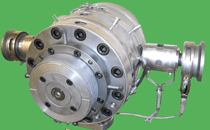New extrusion tooling making its mark in 3-layer drip irrigation lines
How often does technology originally developed for the medical market find its way to the agricultural and horticultural landscape? Well, it happens, and proof can be found on the stand of Guill Tool & Engineering at the K show, which starts Oct. 27 in Düsseldorf, Germany. Pipe and tubing processors attending the triennial event will want to find time to visit to see the tooling manufacturer's latest developments.
October 19, 2010
How often does technology originally developed for the medical market find its way to the agricultural and horticultural landscape? Well, it happens, and proof can be found on the stand of Guill Tool & Engineering at the K show, which starts Oct. 27 in Düsseldorf, Germany. Pipe and tubing processors attending the triennial event will want to find time to visit to see the tooling manufacturer's latest developments.
|
One of the key benefits of this new Guill extrusion tooling is that it allows an inexpensive regrind polymer to comprise the bulk of the material inside the tube, hose or pipe, with very little virgin material needed to completely encase it. |
Guill's new tooling for drip irrigation tubing makes its mark by hitting on some of the hottest themes going: water conservation and environmental protection. The tooling utilizes a spiral flow that handles three layers to extrude the tubing necessary for efficient and environmentally safe drip irrigation. The technology is based on the company's 800 Series for extrusion of medical tubing as well as other Guill (Warwick, RI) tooling innovations.
Prior to this advancement, only two layers were common. One of the key benefits of this tooling is that it allows an inexpensive regrind polymer, or most any type of polymer, to be the bulk of the material inside the tube, hose or pipe.
The new drip irrigation crosshead/die is designed to produce a tube that uses an A/B/A, A/B/C or virtually any type of three-layer construction, according to the manufacturer. In this application, the inner layer is composed of a majority of a less expensive regrind material (or any polymer desired) and is typically surrounded by a very thin layer of virgin polymer, often times only 1/1000th (.0001) of an inch (.00254 mm) thick or less. Guill claims that its patented flow design requires less plastic for the walls of the tubing to achieve the desired or mandated tube-burst strength requirements.
The Guill tooling three-layer model for drip irrigation is currently offered in measurements ranging from 5/8 of an inch to one inch (15.875 mm - 25.4 mm). The new Guill three-layer design is suitable for flat or round tubing for various types of emitters-sprays, drip holes, or other types. The objective is to enable tube, hose and pipe extruders to have the most cost-effective drip-irrigation systems that control the exact amount of water and fertilizer required.
According to Bill Conley, Guill's technical sales manager, "Our current three-layered solution for drip irrigation is one of our most popular layered technologies being offered. It can have stripes or other markings for identification on all pipe, hose and tubing extrusion. The most important aspect of this three-layer design is total confidence for the user-the virgin material completely and securely surrounds all other layered materials utilized, such as regrind. This ensures protection against any potential environmental concerns with hosing or tubing today with increasingly stricter regulations likely to follow."
Guill incorporates a number of its patented technologies in this new tooling. Patented spiral engineering helps ensure upstream thermal balancing, generating equal flow of material through the die to ensure extremely close tolerances. Guill's patented Feather Touch design for easy concentricity adjustment enables low-effort concentricity adjustment without choking off the upstream.
About the Author(s)
You May Also Like



